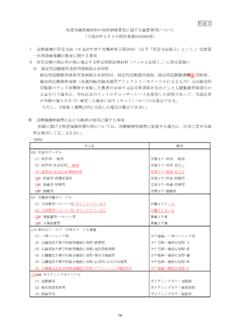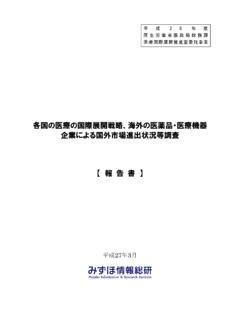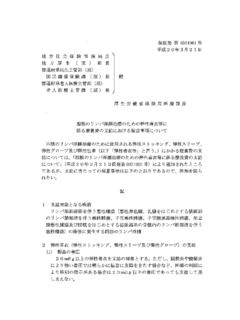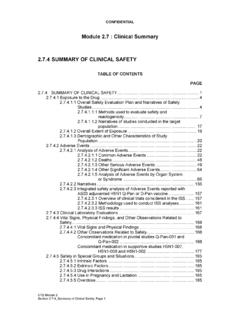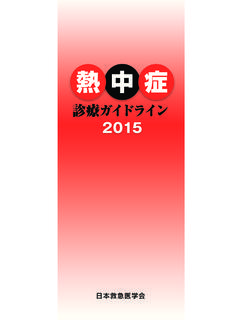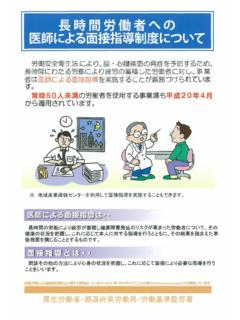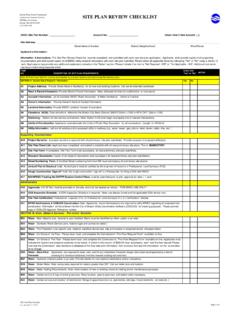Transcription of Policy and Administration of Water Supply in Japan
1 Ministry of Health, Labour and Welfare, Government of Japan Water Supply Div., Health Service Bureau PPoolliiccyy aanndd AAddmmiinniissttrraattiioonn ooff WWaatteerr SSuuppppllyy iinn JJaappaann 1. History (Development of the Modern Water Supply System) Japan s first modern Water Supply system was introduced in Yokohama and began its operation in 1887. At the time, the modern Water Supply system, which provides purified Water with pressure through mains, was needed to prevent the infection of Water -borne diseases. Following the operation in Yokohama, the Water Supply system spread in municipalities all over Japan .
2 However, the number of patients suffering from Water -borne diseases had not been decreasing until the chlorination was imposed by the Waterworks Act, which was implemented in 1957. Through the strict Water quality control required by the Act, tap Water got to be safe and drinkable without boiling. Today, very few people suffer from Water -borne diseases, thanks to the achievement of nearly 100 % coverage of Water Supply in Japan . The original of Waterworks Act (1957) Pipe installation construction in Yokohama city in the early 1910s Nishiya Treatment Plant in Yokohama city (1915) 0246810121416181880 1900 1920 1940 1960 1980 20000102030405060708090100 Coverage (%)DisinfectionsNumber of Patients(Cholera, Dysentery, Typhoid, Paratyphoid) 103persons Introduction of modern waterworks1957.
3 Water Works Law(Chlorination) 100 90 80 70 60 50 40 30 20 10 01957. Water Works ActIntroduction of modern Water Supply system-1- 2. Waterworks Act Water Supply in Japan should be managed/operated following the requirements designated by the Waterworks Act, which was enacted in 1957. The Waterworks Act provides; Drinking Water quality standards Standards for facilities Application for license of a Water utility and its approval Operation of a Water utility Supervision of Water utilities Government s financial assistance Other rules 3. Role of Ministry of Health, Labour and Welfare(MHLW) Governance of the Waterworks Act Business license * Establishment and revision of the standards for facilities, drinking Water quality, and Water service installations Supervisory guidance and site inspections * Financial assistance Research and development of technologies *) as for small-size Water utilities, prefectural governments are in charge, 4.
4 Role of Water Utilities In principal, a Water utility is operated by a municipal government. Any party except for a municipal government of the service area needs an approval from the municipal government for the business of a Water utility. A Water utility, whose service population is more than 100, needs to obtain a license. -2- The Categories of Water Utilities in Japan Water Utilities (9,202 Entities) In principal, managed by municipalities Water Utilities for Bulk Water Supply * (102 Entities) *) Bulk Water Supply means wholesale of purified Water to Water utilities In most of the case, managed by a prefectural government or a cooperative body organized by municipalities The Ministry of Health, Labour and Welfare (MHLW)
5 Gives a license to Water utilities with the service population of 50,001 or over, or Water utilities for bulk Water Supply with the maximum distribution volume of more than 25,000 m3 /day . Prefectural governments give a license to Water utilities or Water utilities for bulk Water Supply whose sizes are not large enough for applying to a license to MHLW. Water utilities may entrust services to a third party. Small-size utilities may have partnership with larger public Water utilities or private sectors. Compliance with Regulations Water should be supplied continuously in compliance with the Standards Facility standards 9 Prescribed as performance standards for Water Supply facilities 9 Best cost-effective technology can be chosen according to the local conditions, as far as tap Water can meet the drinking Water quality standards stably.
6 Drinking Water quality standards 9 Prescribed values for 50 items (as of April 2009) 9 In accordance with the WHO-Guidelines for Drinking Water Quality Establishment of the Rules of Water Supply Prescribed in the ordinance of the municipality Ta r i ff Payment charged on Water consumers for the cost of Water service installations Assurance of Hygiene -3- Disinfection Tap Water should contain no less than mg/L of residual chlorine Examination of residual chlorine should be conducted at Water taps every day Medical check-ups of workers Workers in treatment plants should have medical examination for Water -borne diseases every 6 months
7 Prevention of contamination Water Supply facilities should be cleaned up. Provision of Information Water utilities shall provide information to consumers. Annual plan of Water quality examinations Results of Water quality examinations Structure of the organization Costs of business / Tariff Water service installations / Facilities Risk management Financial Management Independent accounting system (self-supporting system) In principal, the cost of Water Supply should be covered by tariff paid by consumers. Tariff system Designated by diameter, consumer type, etc. Progressive system (As more Water is consumed, higher rates are applied.)
8 YearOthersPurchase of waterDepreciationInterest paidChemical, materialRepairPowerPersonnel020406080100 1201401601802001975198019851990199520002 005 Fiscal YearCost of Water / Unit price of Water (yen/m3)cost of waterunit price of waterCost and Unit Price of Water (National Average) Breakdown of the Expenditure of Water Utilities in Japan -4- 5. International Contributions The World s Top Donor in Water and Sanitation Sector Our responsibility, as a member of the international community, is to ensure the quality of drinking Water Supply in developing countries through ODA and other schemes.
9 Cooperation with international organization Cooperation in the construction of Water treatment plants Technical cooperation related to capacity development Acceptance of trainees from developing countries to Japan Water and Sanitation Broad Partnership Initiative (WASABI) Launched in the 4th World Water Forum in Mexico by the government of Japan (2006) Provision of safe drinking Water and sanitation 9 Measures in rural communities: Supply of Water and sanitation with consideration to local conditions and capacity of development 9 Measures in urban areas: Utilization of private sector funds to meet large-scale funding needs; Support for management and monitoring measures Seminars on Water Supply Co-Hosted by Japan and Other Asian Countries MHLW organizes seminars on Water Supply with other governments of Asian countries to introduce and exchange information on engineering techniques, legal regulations, conditions of operation/maintenance and other relevant topics of Water Supply in each country.
10 Japan China Seminar ( , 2008) Japan Cambodia Seminar ,2008 -5- 6. Topics Leakage Control National average of effective Water ratio* is 92%. (Leakage is 8%). Leak detection plan Rehabilitation of old pipes *) effective Water ratio = (amount of Supply amount of leakage) / amount of Supply The national goals of this ratio are set to be 98% for large utilities and 95% for small utilities. Measures against Earthquake Earthquake-resistance standards for facilities Development of promotional programs to enhance earthquake safety of facilities Urgent renewal of aging and weak pipelines Securing of capacity for distribution reservoirs satisfying 12 hour demand Installation of emergency cutoff valves Installation of extra pipe lines for backup Development of emergency Water Supply at evacuation sites YearEffective Water ratio (%)
